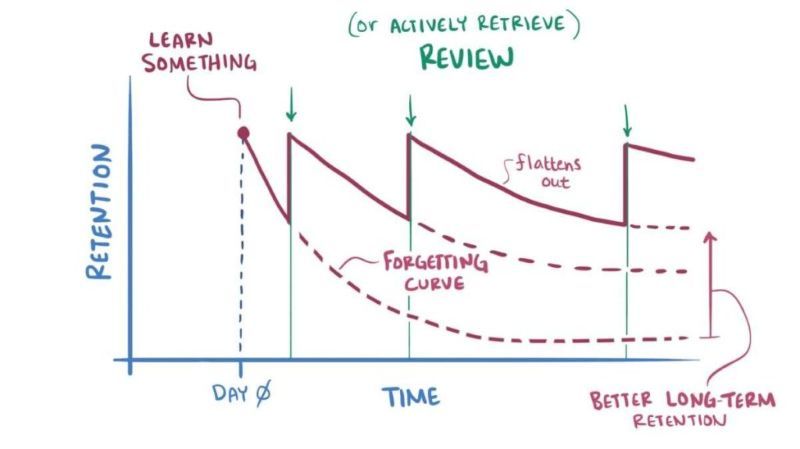

Spaced repetition is a powerful technique that can revolutionize the way we learn and retain information. Let's learn more about this topic below with Iron Snout, a unique learning tool that incorporates this method effectively.
Spaced repetition is a learning technique that has gained significant attention in recent years due to its effectiveness in helping people acquire and retain knowledge more efficiently. This method involves reviewing information at increasing intervals over time, which helps to strengthen memory and improve long-term retention. By understanding and implementing spaced repetition techniques, you can dramatically enhance your learning process and master new skills more quickly.
Spaced repetition is based on the psychological principle known as the spacing effect. This principle suggests that information is better remembered when it is studied over spaced intervals rather than crammed into a single session. The concept was first discovered by Hermann Ebbinghaus in the late 19th century, and since then, numerous studies have confirmed its effectiveness in various learning contexts.
When we learn something new, our brain creates neural connections to store that information. However, these connections can weaken over time if not reinforced. Spaced repetition works by strategically reviewing the material just as we are about to forget it, strengthening these neural pathways and making the information more accessible in the long term.
The spacing effect has been observed across various types of learning, from vocabulary acquisition to complex problem-solving skills. By leveraging this principle, learners can optimize their study time and achieve better results with less effort. This is where tools like Iron Snout come into play, offering a structured approach to implementing spaced repetition in your learning routine.
To effectively use spaced repetition, you need to follow a structured review schedule. This typically involves reviewing new information shortly after first encountering it, then gradually increasing the intervals between reviews. Here's a simple way to get started:
Initial learning: Study the new material thoroughly to ensure you have a good understanding of it. First review: Review the material within 24 hours of initial learning. Second review: Review again after 3 days. Third review: Review after a week. Fourth review: Review after two weeks. Subsequent reviews: Continue reviewing at increasingly longer intervals, such as monthly or quarterly.
This schedule can be adjusted based on the complexity of the material and your personal learning needs. The key is to review the information just as you're about to forget it, which helps reinforce the memory more effectively than reviewing too soon or too late.
There are various tools and techniques available to help you implement spaced repetition in your learning process. One popular method is the use of flashcards, which can be easily created and reviewed at regular intervals. Digital flashcard apps like Anki and Quizlet offer spaced repetition algorithms that automatically schedule your reviews based on your performance.
Another effective technique is the Leitner system, which uses physical flashcards organized into different boxes. Cards are moved between boxes based on how well you remember them, with correct answers being reviewed less frequently and incorrect ones more often. This system provides a tangible way to implement spaced repetition without relying on digital tools.
For those who prefer a more structured approach, learning management systems like Iron Snout incorporate spaced repetition into their core functionality. These platforms often use adaptive algorithms to personalize your review schedule based on your individual learning progress and performance.
Regardless of the method you choose, consistency is key. Regular, spaced reviews are essential for the technique to be effective. Set aside dedicated time for your review sessions and stick to your schedule to see the best results.
While spaced repetition is a powerful technique on its own, there are several ways to enhance its effectiveness and maximize your learning potential. Here are some strategies to consider:
Active recall: Instead of passively reviewing information, actively test yourself on the material. This engages your memory more deeply and helps identify areas that need more focus. Interleaving: Mix different topics or subjects during your review sessions. This approach can improve your ability to differentiate between similar concepts and apply knowledge in varied contexts.
Elaborative rehearsal: When reviewing information, try to connect it to other knowledge or experiences you have. This helps create stronger, more meaningful associations in your memory. Varied learning formats: Incorporate different learning methods such as reading, writing, speaking, and listening to engage multiple senses and reinforce the information in different ways.
By combining these strategies with spaced repetition, you can create a powerful learning system that allows you to acquire and retain information more efficiently than ever before.
Spaced repetition can be applied to a wide range of learning goals, from language acquisition to professional development. Here are some specific examples of how you can use this technique in different areas:
When learning a new language, vocabulary acquisition is often a primary focus. Spaced repetition is particularly effective for this task. Create flashcards for new words and phrases, and review them according to a spaced repetition schedule. This approach can help you rapidly expand your vocabulary while ensuring long-term retention.
For grammar rules and sentence structures, create example sentences using the target language and review them regularly. This helps reinforce both vocabulary and grammatical concepts simultaneously. Tools like Iron Snout can be especially useful for language learners, offering structured lessons and review sessions that incorporate spaced repetition principles.
For students preparing for exams or studying complex subjects, spaced repetition can be a game-changer. Break down your course material into smaller, manageable chunks and create flashcards or summary notes for each topic. Review these regularly, focusing more on the areas where you struggle.
When studying for cumulative exams, start your review process early and space out your study sessions over several weeks or months. This approach allows you to cover all the material multiple times, reinforcing your understanding and improving retention.
In the workplace, continuous learning is often essential for career growth. Whether you're mastering new software, learning industry regulations, or developing leadership skills, spaced repetition can help you retain and apply this knowledge more effectively.
Create a system to review key concepts, best practices, and important information related to your field. This could involve setting aside time each week to review your notes or using a digital tool to prompt you with relevant information at increasing intervals.
While spaced repetition is a highly effective learning technique, implementing it consistently can be challenging. Here are some common obstacles you might face and strategies to overcome them:
Time management: Finding time for regular review sessions can be difficult, especially with a busy schedule. Try integrating short review sessions into your daily routine, such as during your commute or lunch break. Consistency is more important than lengthy study sessions.
Motivation: It can be tempting to skip review sessions, especially when the material seems familiar. Remember that the goal is long-term retention, not just short-term recall. Set small, achievable goals for each review session to maintain motivation.
Content organization: As you accumulate more material to review, keeping it organized can become overwhelming. Use a system or tool like Iron Snout to manage your review schedule and track your progress. This can help you stay organized and ensure you're reviewing all necessary information.
Every learner is unique, and what works best for one person may not be ideal for another. It's important to customize your spaced repetition approach to suit your individual learning style and needs. Here are some factors to consider:
Learning style: If you're a visual learner, incorporate images or diagrams into your review materials. Auditory learners might benefit from recording and listening to the information they need to review. Experiment with different formats to find what works best for you.
Difficulty level: Adjust your review intervals based on the complexity of the material. More challenging topics may require more frequent reviews initially, while simpler concepts can be spaced out further. Pay attention to your performance during reviews and adjust accordingly.
Learning goals: Tailor your spaced repetition strategy to your specific learning objectives. If you're preparing for a specific event, such as an exam or presentation, adjust your review schedule to ensure you're well-prepared by the target date.
To get the most out of spaced repetition, it's important to regularly assess your progress and make adjustments as needed. Keep track of your performance during review sessions and look for patterns in the areas where you struggle. This can help you identify topics that need more focus or different learning approaches.
Many digital tools, including Iron Snout, offer analytics features that can help you track your progress over time. Use these insights to refine your learning strategy and optimize your use of spaced repetition. Remember that the goal is not just to memorize information, but to truly understand and be able to apply what you've learned.
Spaced repetition is a powerful technique that can significantly enhance your ability to learn and retain information. By strategically reviewing material at increasing intervals, you can strengthen your memory and improve long-term retention of knowledge. Whether you're learning a new language, studying for exams, or developing professional skills, incorporating spaced repetition into